Rather than hire vehicles to cover delivery peaks, the John Lewis Partnership calls up its ‘mothballed’ fleet to keep costs down and maximise productivity.
An innovative approach to fleet management which prioritises productivity and cost savings during periods of peak demand over absolute utilisation of all assets has seen the John Lewis Partnership (JLP) develop a dual fleet strategy with two operations effectively running in tandem.
The company, which owns John Lewis and Waitrose, has a primary fleet of vans and trucks, managed over a 7.5-year cycle, and a ‘mothballed’ fleet of ex-primary vehicles which are kept for up to two more years to address peak demand for services, such as Christmas when the fleet swells by 30%.
At a time when fleets talk about maximum utilisation and minimising the number of vehicles they operate, it might appear a luxury to have 250 vehicles sitting around not turning a wheel for large parts of the year.
However, there is a robust business justification for the policy.
The mothballed fleet means the company does not endure the expense of rental at these busy times – reducing costs by around 30% – and also ensures it has vehicles in the precise specification it needs, which boosts productivity.
Key is John Lewis’s seven workshops which ensure these older vehicles are kept in prime condition, ready to go at a moment’s notice.
The mothballed fleet is just one of the novel tactics employed by general manager, fleet Justin Laney to manage his fleet operation of close to 5,000 vehicles.
“We purchase all our fleet, from cars to trucks and trailers, and we make them last longer than most,” Laney tells Fleet News.
“Our fleet model is to buy equipment that is designed for our purposes. But, because it is specialised and the vehicles are on a long life cycle, it is less attractive to leasing companies because the residual value is low.
“So we fund the fleet and we maintain it in-house to keep standards high and the costs down. It also gives us the flexibility to de-fleet early if that is appropriate.”
In-sourcing is a theme for the 150-strong central transport team, which includes 100 workshop employees, plus fleet management staff, the car team, compliance, a driver risk manager and a call centre which handles externally-maintained vehicles spread across more than 300 sites.

Home counties headquarters
Central transport provides support to both John Lewis and Waitrose and is headquartered in Bracknell, Berkshire, on a Waitrose mini-metropolis, a 75-acre site comprising seven office blocks.
It acts as an internal leasing company, buying the vehicles and leasing them to each cost centre with an aim of breaking even.
“The business looks to us to come up with solutions. Our role is to provide guidance about what is best policy,” Laney says.
The head office site includes the company’s largest workshop and a body repair shop with a full-size oven that can accommodate 44-tonne trailers. It operates 24 hours a day, 6.5 days a week.
“The workshops are mainly for the bigger vehicles, but we will suck in smaller ones in each locality,” says Laney.
“We are also looking at pulling in vehicles from further afield for MOT and cosmetic repairs. We have to control the look of the fleet because we keep it for longer, as well as the mechanical safety.
“Our workshops combine the best of the dealer world, such as productivity, with the best of fleet, including vehicle standards and safety, and we empower people to have a say in how the workshop is run.”
Unlike most operators with a sizeable van and truck fleet, the JLP team also manages the car fleet in-house. Responsibility rests with three staff.
By Laney’s own admission, it is a more “hands-off” relationship, largely because the majority of the 1,500 cars are perk vehicles on an employee car ownership (ECO) scheme. Staff choose to have the cars for either three or four years.
“ECO is tax-efficient for both our partners and the partnership,” he says.
“It works for us, and could work even better with the new WLTP – it will be interesting to see how changes in BIK will affect the balance of ECO versus conventional funding.”
Laney, who has been in fleet for 35 years, the past eight at John Lewis, outsources very little fleet responsibility.
Exceptions include tachograph analysis and accident management/claims handling for anything large, including third party claims. Pretty much everything else stays within the fleet team.
“We ask ourselves whether it is better and cheaper to do it in-house,” says Laney. “And we find that it is.”
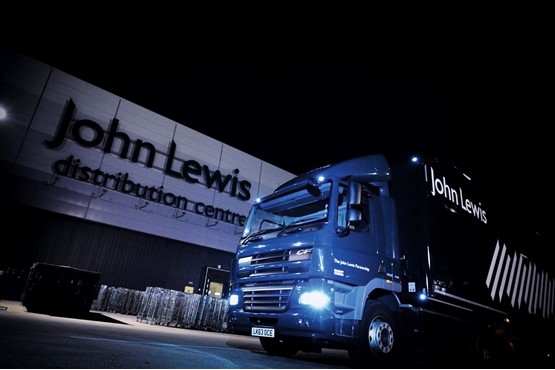
Time of massive change
Having such a breadth of knowledge within his fleet team helps Laney grapple with the rapidly evolving fleet sector, everything from alternative fuels to mobility services technology.
“It’s a time of massive change in commercial vehicles and it’s being speeded up,” he says. “Alternative fuels, air quality, operating trucks in urban areas, autonomy, connected vehicles and electrification – it’s important we make the right decisions.”
Laney works closely with academics, including the Centre for Sustainable Road Freight, to identify technologies with potential and how quickly they might come to market.
When he wanted to trial low carbon fuels, he approached Imperial College London to collaborate on a biofuels programme, assessing various sources of waste to fuel the biomethane trucks.
For electric vehicles, he worked with Cambridge University, concluding that “we will electrify our small vehicles over time, but for trucks it will be 20-25 years before there is a solution that can be rolled out widescale”.
Until then, he will continue to pursue a strategy of replacing diesel trucks with biomethane as they come up for disposal. John Lewis operates 53 now with 68 due on fleet within four months and a further 100 next year.
“It works because it reduces CO2 by around 83% on a well-to-wheel life cycle,” Laney says.
“Drivers prefer them because the noise is about half that of a diesel truck and that also has benefits in urban areas where noise is important for night-time deliveries.
“The business case works – the payback on investment is broadly two years.”
The cost of gas depends on the price of setting up a fuelling station. Laney works with CNG Fuels which builds fuelling sites at locations where JLP commits to investing in the trucks. Ultimately, it will probably have to build its own infrastructure.
While elctric is not ready for trucks, one area where it could have a significant and more immediate impact on emissions is on refrigerated trucks where the fridge units are powered by old technology diesel which is “barely Euro 1”.
“So our bio trucks have electric-powered fridges, which make them perfect for night-time deliveries,” Laney says.
“Because the LLCS (London Lorry Control Scheme) is about noise, a vehicle like this should be exempt and able to take the route of most efficiency, whereas the scheme promotes longer distances at the wrong time.
"We are talking with Transport for London about this and there is a lot of interest.”
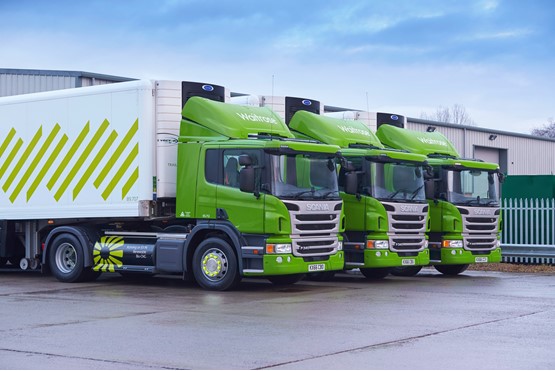
Sensible choice
Electric is also the most viable solution for vans. John Lewis has some biofuel LCVs but believes the likelihood of zero emission zones being introduced in many city centre makes electric the sensible choice to pursue.
It has already trialled some, but payload was an issue, so there was no business case. Now, with the Government derogation on O-licences to 4.25-tonnes to take battery weight into consideration, it has gone from “cost-negative to cost-positive”.
Laney adds: “If you can take half the payload again than a diesel, it reduces congestion – that could be a game-changer.”
He is in talks with EV newcomer Arrival, which is “very promising”, but he has some concerns.
“The problem with steel vans is their life is determined by corrosion – the body rots. That’s fine on diesel, but on an EV, we don’t want to bin it after seven years,” he says.
“If they build it from aluminium and composites, it will have a longer life. EVs are expensive, so they have to last.”
Laney has a structured approach to the introduction of new technology. “First filter out the chaff by engaging the academics,” he says.
“Then we trial a vehicle; then we buy 10 to 20 of them. If that works, we go for 30, 40, 50. It’s a three-to-four-year lead time.”
One of his, and JLP’s, principal priorities is driver safety. The company operates a toolkit which is applied in different ways dependent on the type of vehicle.
Car drivers have a scaled-back version, but Laney is working on typically resourceful plans to overhaul the entire driver risk management process.
Currently, driver risk is measured in conventional ways, such as accident records and points on licence, with interventions including training and assessments designed to transform high risk drivers into low risk.
Laney is seeking a “more nuanced system” that prevents accidents before they happen.
He has introduced a series of daily “nudges or messages” which update the driver on good or poor behaviour. Sent to their handheld device, these will inform the driver if they have, for example, been braking heavily that day which will affect their risk score.
If they transgress again, the next message will advise them to undergo training and if that does not resolve the issue, a meeting will be scheduled with their line manager.
The initiative, expected to launch within the next 12 months, isn’t intended to only communicate the ‘bad news’. It will also congratulate drivers on good performance in an attempt to inspire them to be the best.
Laney is considering supporting this with driver awards, recognising the best by depot, area, within business unit and also by the type of vehicle they are driving.
“It’s a two-way path; we hope people will take the one to make them a better driver,” he says.
Jerry Ward, John Lewis manager legal operations (transport), adds: “We are a high profile brand – our drivers can be measured by the public.”
Laney is already thinking about further developments. “There could be a role for artificial intelligence looking at the environment, road conditions, load, demographics, and then we could tailor messages to that area – for example, informing the driver it will be icy on their route that morning,” he says.
“These are all things that help the driver and reduce stress. Ultimately, we could reduce or stop journeys if we feel the risk is too high.”
The need for more robust driver risk programmes accelerated with the explosion in home delivery.
It has accounted for JLP’s van fleet growing from almost zero a decade ago to 1,000 today. More than half of goods sold are bought online and a large proportion are delivered to the home. This will continue to proliferate.
The company initially had a tie up with Ocado for Waitrose but started to set up its own operation in the late 2000s as home delivery became an increasingly important part of both businesses.
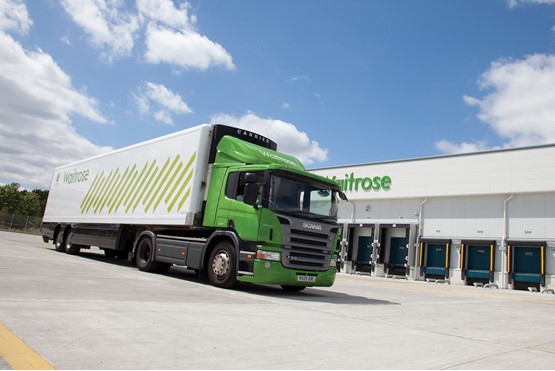
Initial issues of cost per drop are fading as density rises, making the operation more productive and efficient.
This was further boosted by switching from a box body van to a custom-built body which increased load capacity by 50% and used lighter materials to improve fuel efficiency, enabling the vans to accommodate longer routes.
The home delivery service also prompted a change to risk management policy.
“They are our highest risk drivers because they are in urban areas, doing more reversing and they are not vocational drivers,” Laney says.
“Plus they are spread around 200 sites with non-specialist managers. So we started a new team to monitor risk with a permit to drive and a permit to operate so each – driver and transport operation – had to jump through hoops to be qualified.”
The permits cover a number of areas, including audit scores, action plans, compliance to the driver management process such as daily checks and licence checks, reaction to accidents and vehicle cleanliness.
It’s working, according to Laney: “We’ve never withdrawn a licence from a branch,” he says.
Home deliveries have also raised the central transport team’s profile within the business not least as connected technology makes it easier for product manufacturers to link directly to end customers.
“It’s an interesting conundrum; we have to add value and be a destination,” Laney says. “Previously we were seen as a necessary cost; now we are a differentiator and a key part of the customer experience.”
One way John Lewis is adding value is by extended the services offered by its home delivery drivers to customers.
“We have built in more time per delivery so they can, for example, take goods into the kitchen,” Laney says.
“We also offer home installations where the drivers fit lights or plumb in. Our staff get driver training, and training to be customer-facing and for the installation of goods.”
Connectivity is also helping John Lewis to minimise ‘empty legs’ journeys, where its vans and trucks return empty.
It has been operating a ‘back haul’ service for suppliers for a number of years, collecting products from manufacturers or smaller companies for whom the cost of transport would be too great.
“We can consolidate into our warehouse and use our trucks,” Laney says. “We also do forward haul, where we take their goods out and bring ours back. This is a growing area and it is a profit centre in its own right.”
Laney continues to investigate all the latest technologies, assessing which ones have a potential role to play on the fleet.
“We need solutions for air quality, carbon reduction, the urban environment and we have to plot a path through new technologies while maintaining our focus on manager risk and developing drivers to be safer and safer,” Laney says.
“There is no longer a one-size fits all for fleet.”
* By sales, the John Lewis Partnership is the third largest non-traded company in the Sunday Times Top Track 100. It has more than 85,000 partners in the business. In two years’ time it will celebrate its centenary.
Autonomous trucks are ‘potential game-changer’
Justin Laney believes autonomous technology is “a potential game-changer, especially with heavy trucks where there is a driver shortage”.
It could have a large impact on operational costs if trucks can run without drivers, although he is quick to reassure his drivers that this is a long-term view of the market.
“We can’t jump in too early. The challenge is knowing about which technology to back and how quickly to jump in,” Laney says. “But autonomous, as in driverless, is probably 15 years into the future.”
He adds: “The economics of autonomy will drive adoption, but they will have to be demonstrably safer than the average driver before they can proliferate.”
Laney is actually more concerned about mid-level autonomy, so-called Level 3 and 4, than he is full autonomy.
“It’s easy to get over-relaxed when the car is doing its thing, but then, if it has to hand back control, research shows it takes six seconds for the driver to regain control – you can travel a long way in that time,” he says.
“It’s tempting to jump straight in at Level 5 rather than go through Levels 3 and 4.”




















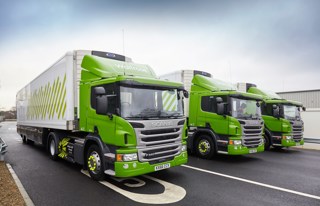
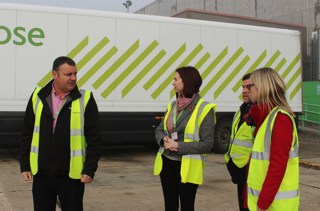
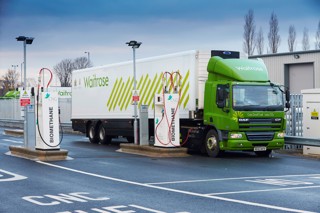
jim - 21/08/2018 14:30
Could be some scope to improve the funding of the vans to Finance Lease; comparing cash and an IRR cost of 6 - 9% to funding (at say 3%), with the benefit of a slightly improved cash flow (as VAT is reclaimed quicker by the finance company) plus and dependent on how JL takes the OEM rebate (off invoice price or cash) further savings could accrue... I also agree with position on ECO - but as one of their competitor says - every penny counts!!!